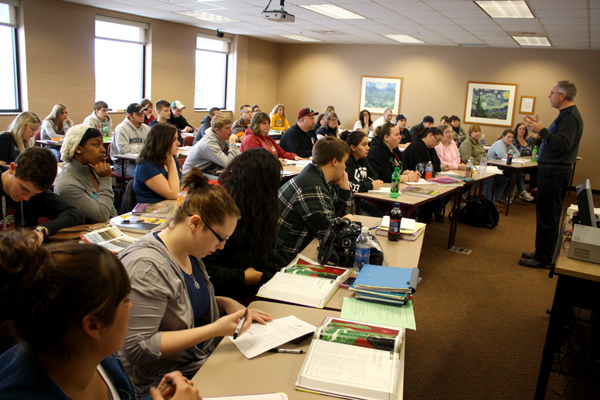Troubling times for Michigan’s community colleges
On the surface, the numbers are dismal.
Just 15 percent of Michigan community college students earn a two-year associate’s degree in three years, according to the latest federal data.
About 60 percent of first-year community college students need remedial courses (essentially, do-overs on subjects they should have learned in high school), which students must pay for and pass before they can start earning college credits.
And community college enrollment in the state is falling.
“It’s certainly under no one’s definition of something we should be proud of,” said Brandy Johnson, executive director of the Michigan College Access Network, which advocates for increasing the number of Michigan residents obtaining two- or four-year college degrees and certificates.
Michael Hansen, president of the Michigan Community College Association, which represents the state’s 28 community colleges, acknowledges, “We have our work to do.”
But Hansen and Johnson say the grim federal data can be misleading because the numbers fail to consider the complexity of the student populations served by community colleges.
Community colleges serve a wide range of students, some of whom have been out of high school for years before enrolling. The average age of a community college student in the 2013-2014 academic year was 26.4 years.
Two-thirds of Michigan’s approximately 213,000 community college students are enrolled part time and more than half take classes with the intent of transferring to a four-year university, most without bothering to get a two-year associate’s degree.
Students who transfer to another college or four-year university without getting an associates degree are not counted as having graduated by the federal government.
A prominent example of that kind of student is Michigan Gov. Rick Snyder, who accumulated 25 college credits while in high school through a dual enrollment program at Kellogg Community College in Battle Creek and transferred them to the University of Michigan.
Hansen said community colleges encourage students bent on transferring to a four-year university to get an associate’s degrees before they leave, both as a way of boosting graduation rates and providing students with a credential that’s valuable in the job market.
“If you are taking accounting classes at a community college with the intent of transferring to Michigan State University to get a four-year accounting degree, you should at least get an associates degree in accounting in case things don’t work out at MSU,” Hansen said.
Hansen said he’s even encouraged Snyder, who often talks about the value of a two-year degree or credential, to get an associate’s degree. Doing so would symbolize the value of a community college education, he said.
Snyder is considering getting his associates degree, probably by seeking community college credits for credits he earned at the University of Michigan, spokesman David Murray said.
While the federal government measures community college graduation rates based on the number of students who get degrees in three years, the state says that measurement is too restrictive because of the large percentage of part-time students and other factors.
“Life gets in the way sometimes,” Hansen said.
Michigan’s educational dashboard measures the percentage of students who complete a degree, earn a certificate or transfer to another college or university in six years.
Community colleges have made progress in that measure, as 52 percent of their students completed a program or transferred last year, up from 44 percent in 2007.
The percentage of community college students who require remedial courses before they are able to accumulate credits in math and English also has fallen slightly, from 63 percent in 2010 to 60 percent last year, according to another state dashboard.
While those statistics remain dismal, the high percentage of remedial course work required by community colleges is a national problem. A 2012 study by Complete College America found that more than 50 percent of community college students required remedial courses, resulting in out-of-pocket costs to them of $3 billion in 2011. Students required to take remedial coursework to gain skills they should have learned in high school are also more likely to drop out of college, according to the Complete College America study and others.
Some attribute the high rates of remedial work to that fact that community colleges, unlike most universities, are open to all students with a high school diploma or an equivalent. Community colleges also are seeing more immigrant students who speak English as a second language and require remedial reading classes.
“We are an open admissions environment,” said Tim Meyer, chancellor of Bloomfield Hills-based Oakland Community College outside of Detroit, which has 27,000 students.
Remedial classes are “a recognition of need rather than a system failure,” he said.
But Hansen said community colleges are working to reduce the need for remedial classes, which can take a semester or entire academic year to complete. Improving diagnostic assessments might reveal that students need to brush up on a few math concepts, for example, rather than needing a full remedial course.
“The average age of our students is nearly 27,” Hansen said. “Sometimes they knew these things but forgot.”
Community colleges also need to improve student retention, which could lead to higher graduation rates, said Johnson, of the Michigan College Access Network.
The percentage of first-year community college students who were still enrolled in their second year fell from 74 percent in 2010 to 71 percent in 2013, according to the Snyder administration’s dashboard.
Community colleges should provide students with a better, more carefully tailored roadmap toward getting a two-year degree or credential, Johnson said.
“There needs to be much more structured pathways for college students, instead of giving them lots of choices that can be a waste of time,” she said.
Economy up, enrollment down
Michigan’s community colleges also are seeing declining enrollments, which could keep Michigan from improving its educational attainment rate at a time when experts say having a two- or four-year college degree is essential to getting a good job.
Fall enrollment at community colleges has fallen from a record of 260,179 students in 2010 to 212,867 students this year, a decline of 47,312 students, or 18 percent.
Enrollments this year dropped at 25 of Michigan’s 28 community colleges, according to the Michigan Association of Collegiate Registrars & Admissions Officers.
Only Gogebic Community College in Ironwood, Henry Ford College in Dearborn and Kellogg Community College in Battle Creek experienced enrollment increases.
Traditionally, community college enrollments rise when the Michigan’s cyclical economy is poor and fall when it improves.
Hansen said many students are finding jobs after graduating from high school or leaving college early to take jobs because employers can’t wait for them to finish their programs.
The state House Fiscal Agency said in a 2013 report that Michigan’s community college enrollment is likely to continue falling.
Contributing to the decline is a shrinking population of high school grads as the state’s school age population declines.
But Johnson said more low-income students might enroll if they were made aware of the availability of federal Pell grants and how to obtain them. Pell grants provide need-based tuition for low-income college students. The maximum individual grant for the 2014-2015 academic year is $5,730, which Johnson said can more than cover the cost of community college tuition.
She said the state also could encourage more community college enrollments by increasing the overall availability of need-based financial aid.
The Snyder administration counters that the state has boosted aid to community colleges by 23 percent between fiscal year 2011 and fiscal year 2015, from $296 million to $365 million. The increase includes funding for operations and assistance for retiree costs.
But fiscal year 2015 funding of $365 million is flat compared to the $294.3 million appropriated in 2005 when adjusted for inflation.
And the state’s share of community college revenues dropped from nearly 50 percent in 1980 to to 19.5 percent in 2013.
Michigan started shifting funding from the school aid fund in 2012 to support much of the community college budget. Nearly 55 percent of the money appropriated to community colleges will come from the fund in 2015.
But the state appropriated an additional $28.7 million from the general fund for community colleges in fiscal 2015, a 2 percent increase.
“Gov. Snyder recognizes the importance of community colleges and the impact they have on students as well as job providers looking for people with in-demand skills. They play a vital role and the state’s investment reflects that,” spokesman David Murray said.
Michigan Education Watch
Michigan Education Watch is made possible by generous financial support from:
Subscribe to Michigan Health Watch
See what new members are saying about why they donated to Bridge Michigan:
- “In order for this information to be accurate and unbiased it must be underwritten by its readers, not by special interests.” - Larry S.
- “Not many other media sources report on the topics Bridge does.” - Susan B.
- “Your journalism is outstanding and rare these days.” - Mark S.
If you want to ensure the future of nonpartisan, nonprofit Michigan journalism, please become a member today. You, too, will be asked why you donated and maybe we'll feature your quote next time!


 A full classroom at Jackson College masks the reality that statewide, community college enrollment is falling. (Photo by Flickr user Jackson College; used under Creative Commons license)
A full classroom at Jackson College masks the reality that statewide, community college enrollment is falling. (Photo by Flickr user Jackson College; used under Creative Commons license) Brandy Johnson of the Michigan College Access Network wants to create more opportunities for students to receive need-based financial aid.
Brandy Johnson of the Michigan College Access Network wants to create more opportunities for students to receive need-based financial aid.